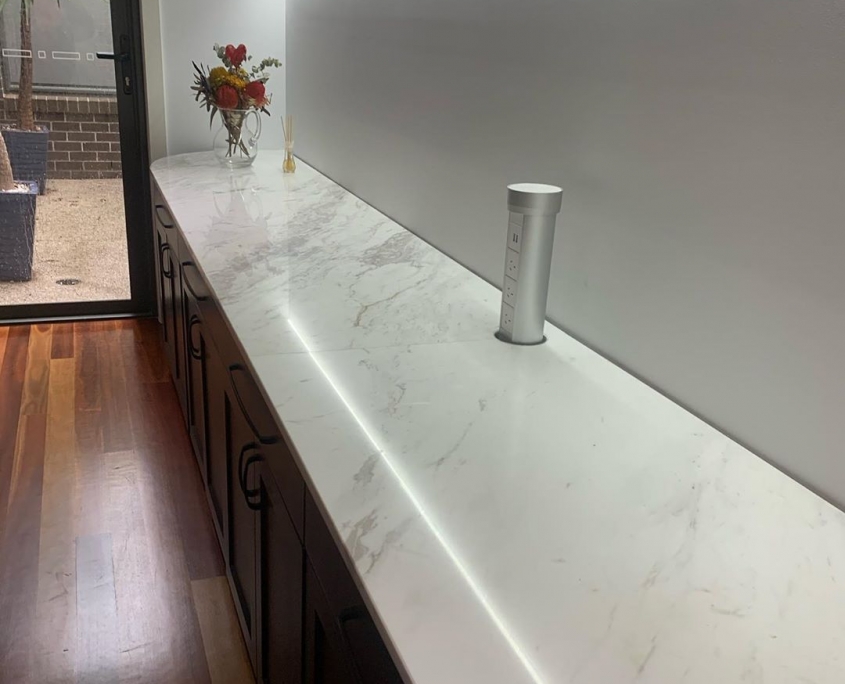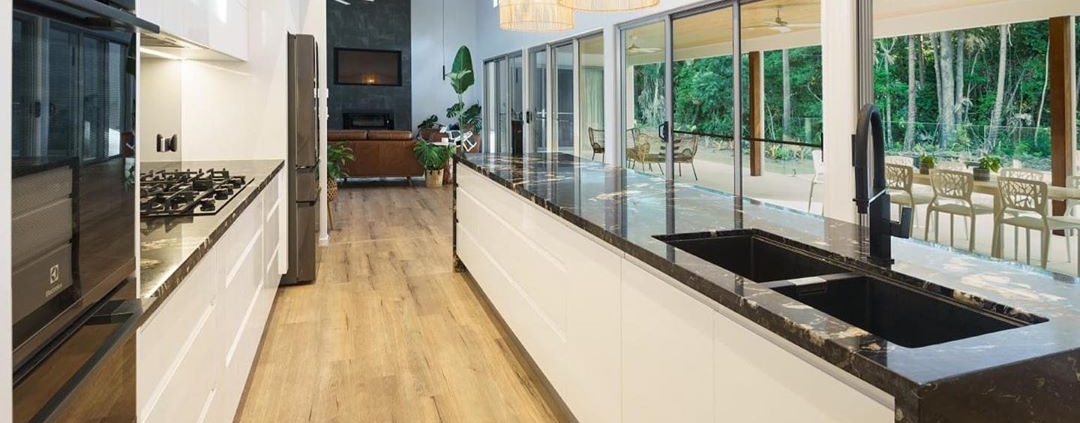4 things to consider when it comes to choosing your kitchen bench stone top and your power points
There are lots of things you need to consider when it comes to installing a stone top in your kitchen, or anywhere else in your house for that matter.
You need to consider things like durability, budget constraints, what it’s going to be used for, as well as how you want it to look.
Stone top benches are a perennial favourite when it comes to kitchens, and for good reason. They’re beautiful, timeless, and it typically lasts a long time.
Apart from deciding where you want it, and whether you’ll be installing pop up power points into it (or might we suggest, how many) here are some other considerations for ensuring you’ll choose something you’ll love – for as long as possible.
Budget
It’s very easy to fall in love with the first marble slab you see, but before you go making any decisions, you need to work out your budget.
Make sure to include any essential extras you may need to account for with your stone top (like pop up power points, tapware, sinks or specific cabinetry), and stick to it.
As a general guide, marble is the most expensive stone top material, which tends to be followed by granite (although this can be as expensive as marble). Engineered stone tops, while not as expensive, can these days often look just as good, and can provide more bang for buck in terms of cost and durability.
Durability
If your stone top is likely to be part of a high use area – like a kitchen or outdoor entertaining area – then you’ll want it to be durable. Out of all the natural stones, granite is the most durable. It is porous, so it will need to be sealed properly, but it will outlast most fittings and features in your house – and probably its occupants, too!
Stone tops like marble, while very beautiful, are soft and porous so needs to be sealed. This is a job best done by professionals, and it needs to be repeated every few years. It can scratch, so be careful when opening cans, bottles of wine, and slicing limes for your gin & tonic directly onto your bench (tip: just don’t!).
Engineered stone is quartz-based, so it can also be very durable. Given that it’s man made, a lot of work has gone into developing the technology behind some engineered stone over the last 20 or so years, meaning a lot of stone tops offer benefits like being heat resistant (no ring marks from hot pans), water repellant and hygienic. It isn’t as porous as granite or marble so doesn’t have to be sealed, but it can chip if you’re not careful.

Image: wolfstoneau
How It Looks
There’s little debate that stone tops look great.
Most come in different colours, with products like engineered stone, not surprisingly, coming in the widest range of colours, from natural looking finishes to more artistic designs.
Marble is arguably the most striking stone top material. As it’s natural, it’s very unique in its design, but be mindful it’s for those who don’t mind the maintenance. It can be polished for a glossy look, or honed for a matt finish.
Concrete is for those who love an industrial look, but note that these are often formed and poured on site, and you may require additional sub-floor structural work for support. You can vary the finishes too – rough, refined or polished, plus the concrete can be tinted at the mixing stage.
Previously, many people have been reluctant to cut into a stone top to install power points, because it ruins the overall aesthetic of the bench. But the beauty with stone tops and power points like Point Pod, is that the integration is seamless – and can be customised to suit whatever material it is you’re using, without compromising on your design.
What You Need It For
Enthusiastic cooks love stone tops like marble, as it tends to be the perfect material for rolling out things like fresh pasta sheets and cookie dough. On the other hand, cooks who are a tad too enthusiastic may find marble comes up second best when pitched against red wine spills and curry feasts, as it can easily stain. You’ll want to make sure you’re using a chopping board when tenderising meat or dicing onions to avoid chips and cracks. If any of this sounds like you or your housemates, we suggest you steer clear of marble; granite or engineered stone will be your best options.
If your bench is outside and likely to get some some sun, you might want to consider your stone top’s UV rating. The sun can be harsh on colours, and many natural and even engineered stone tops are not UV stable. Corian (also known as solid surface) is an engineered stone top that uses a binder made from pure acrylic, making is better UV-rated than most other materials.
If you are wanting to be able to install pop up power points into your bench as a definite, make sure to check the stone top you’ve chosen fits the bill, in terms of material and thickness. A Point Pod can be used with any material and any thickness, however if the disc that is to go into the top of the Point Pod cup is greater than 20mm, it will need to be machined down to suit.




It’s awesome that you mention that engineered stone benchtops are very durable. I want to get a new benchtop for my kitchen that will last for many years, so I’m thinking about having an engineered stone one installed. I’m going to look for a good business in my area that can install an engineered stone kitchen benchtop for me.
I really appreciate you for publishing this blog here about 4 things to consider when it comes to choosing your kitchen bench stone top and your power points; it’s really a helpful and very useful for us. This is really appreciated that you have presented this data over here, I love all the information shared. Great article!
My wife told me that she wants a durable countertop for our kitchen. She usually cooks in there so I’ll trust what she says about why she needs a durable one. You mentioned that granite is the most durable material for a countertop so I’ll see if I can find one.